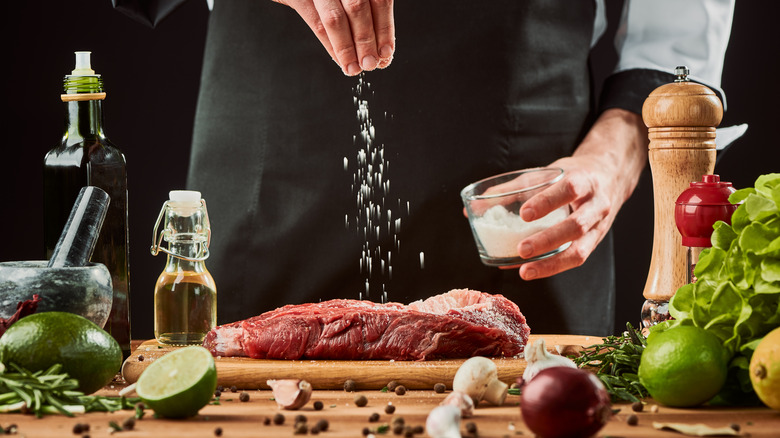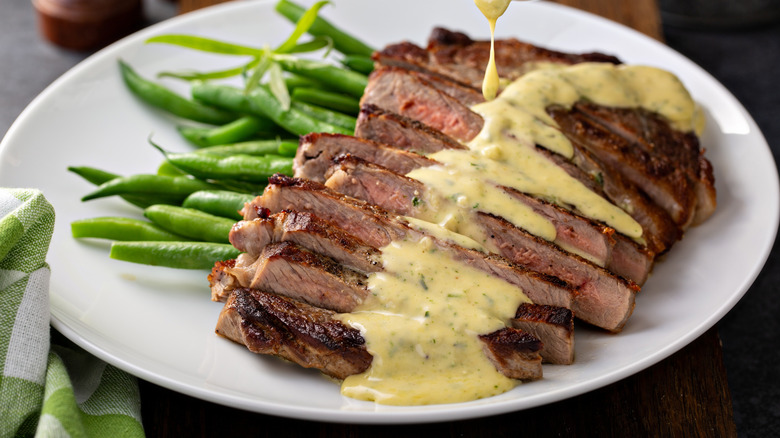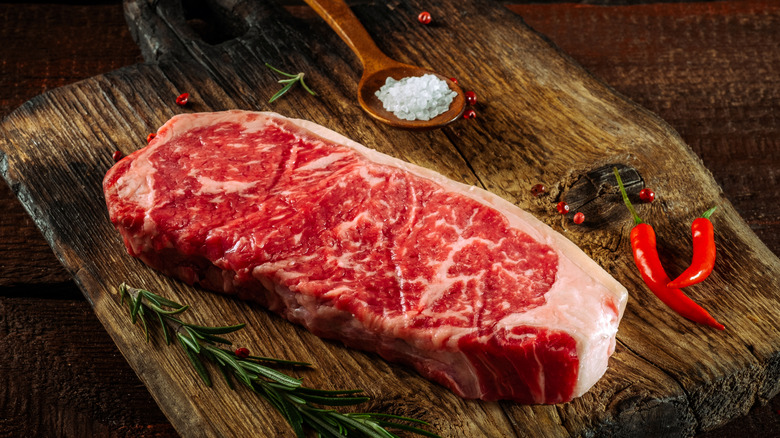The Bath Technique To Fix An Over-Salted Steak
A well-seasoned steak is a thing of beauty. A marriage of fire and flesh, that first bite of the seared, salted crust mixed with the delicious meaty juices is utter perfection for steak lovers. And the salt is about more than just the taste. While a little salt adds flavor to meat, it also helps it retain water for a juicier result, which is always desirable when cooking steak.
But what if you've used too much salt and the flavor is overpowering, the texture is dry, or even worse, the expensive piece of meat has simply become inedible? While it's notoriously tricky to fix over-salted food such as steak, there are a few ways to help rescue the meat and avert a potential disaster.
Techniques and tips range from the very simple, such as using a water bath to rinse the salt off the steak, to adding other ingredients that can help counteract the salty taste. So if your salting has been a bit heavy-handed, there's no need to panic; just try one of the methods to fix it. Though, of course, prevention is better than cure, so the absolute best practice is to salt the meat with a steady hand to begin with.
Rescue over-salted steak with water, acid, or dairy
Adding salt is much easier than removing it. But if you do need to remove some, then the quickest way to get rid of too much salt on a steak is by using running water to rinse it off in a quick bath. Just remove the meat from the heat, rinse it under hot water, and use a paper towel to pat it dry before you serve it up. If you prefer, you could return the steak to the grill or pan to very quickly sear it again after it's been patted dry — before it's rested and served.
Another way to reduce the impact of over-salting is by adding an ingredient to counterbalance the salty flavor. An acid, such as citrus juice or vinegar, can work well here. Plus, there's an added bonus that lemon juice makes steak scientifically more delicious, so it's a win-win.
Alternatively, try tempering the taste of a too-salty steak with a dairy product, like cream or unsalted butter, which adds a little sweetness as well as coats the mouth so that the steak simply seems less salty. Either work well with steak, whether it's basted with butter or served with a cream-based sauce. Or try incorporating both acid and dairy with a zesty lemon butter to melt over the steak, or serve it with a bearnaise sauce incorporating butter, egg yolk, white-wine vinegar, and fragrant tarragon.
How and when to season steak to avoid over-salting
The best way to avoid meat such as steak being over-salted is simply to season it correctly in the first place. But that is sometimes easier said than done, and the results depend on all sorts of things — from when it's advisable to add the salt, to the kind of salt, and how much to use.
Even pros are divided about whether it's better to salt meat several hours in advance or right before cooking. Really, it comes down to personal preference. As for how much to use, for steakhouse Hawksmoor (voted second best steak in the world), with a branch in New York City and another opening in Chicago as well as several in the U.K., the best technique is to throw salt at a steak that has been patted dry, and "whatever sticks is the right amount" (via Hawksmoor).
Steer clear of the table salt since coarse salt is the indisputable best type of salt to season steak with, giving a great flavor as well as a beautiful crust. If in doubt, try adding salt in different stages of cooking, rather than all at once, so the layers of flavor can be built up to your taste. And if you do end up using too much, then just follow the advice to remove some, and learn from the mistake for the next time you fire up the grill.



